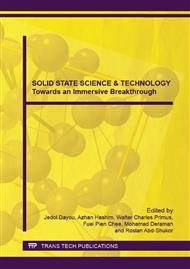p.514
p.520
p.526
p.530
p.536
p.542
p.547
p.553
p.559
Fabrication and Analysis of Photoelectrochemical Properties of Dye Sensitized Solar Cell Using Local Borneon Natural Dye Extracts
Abstract:
Natural dyes were extracted from the plant species Etlingera elatior, Duranta erecta and Amaranthus spp. that were collected from Keningau and Tambunan, Sabah, Malaysia. The possibility of photon-electron conversion was then assessed based on their absorption ability in the region of wavelength between 400-900nm. In addition, FT-IR analysis was carried out to determine if functional groups exists in their extracts. Finally, the DSSCs were assembled and their efficiency measured. It shows the successful conversion from visible sunlight to electricity by using extracts from Etlingera elatior, Duranta erecta and Amaranthus spp. as raw natural dye sensitizers in Dye Sensitized Solar Cells (DSSCs) with efficiency of 0.1% ,0.06% and 0.04%, respectively. This result shows that local natural dyes can be used as sensitizer in DSSCs. However, further investigations are required to improve the efficiency.
Info:
Periodical:
Pages:
536-541
Citation:
Online since:
June 2015
Authors:
Price:
Сopyright:
© 2015 Trans Tech Publications Ltd. All Rights Reserved
Share:
Citation:


